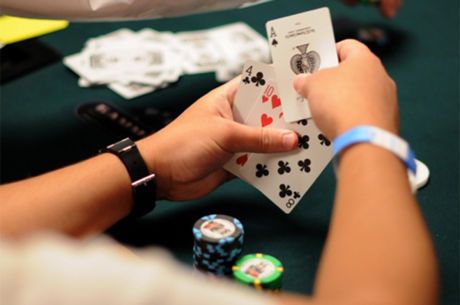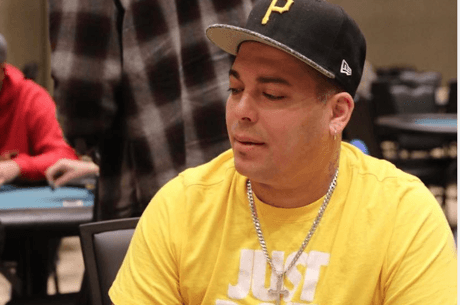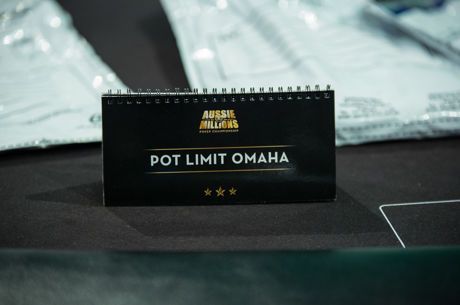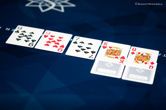Tommy Angelo Presents: Waiting for Straighters, Part II - Pot-Limit Omaha
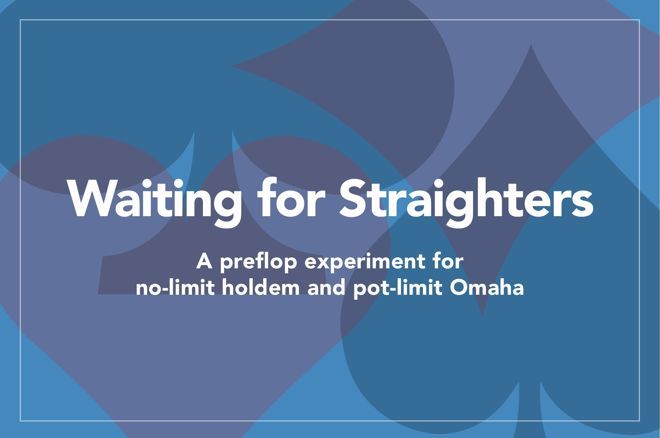
Introduction to Episode 3
In hold'em, a straighter is a hand that can flop a straight. 6-2 is a straighter. 7-2 isn't. In pot-limit Omaha, a straighter is a hand with no pairs, no aces, and no more than two gaps. J-9-8-6 has two gaps, so that's a straighter. J-9-8-5 has three gaps, so it's not.
Waiting for straighters does not mean wait until you get a straighter and then play it. It means wait for a straighter, at least, and then maybe play it. In other words, fold the non-straighters. That's the gist of this article.
This episode is about joyously discovering that my PLO path is paved with straighters.
Waiting for Straighters in Pot-Limit Omaha
You only need seven words to define a hold'em straighter: A hand that can flop a straight.
Defining a PLO straighter is bound to be more complicated than that, and the inherent arbitrariness of the definition, whatever it is, would demand an explanation. So I'm going to start there, with the story of how Harry Kaczka and I came up with what we came up with.
My Relationship to PLO
Did you know Omaha invaded Ohio in 1980? That's when a crazy new rule rode into town. It was baffling. And perfect. And baffling in its perfection. One little rule was enough to create a crazed new level of hysteria for me and my poker buddies:
You must play two cards from your hand and three from the board.
Ten years of mostly-Omaha later, I went full-time pro, and during my first few years of grinding, about half the hands I played were some variety of Omaha (pot-limit, fixed-limit high-only, or fixed-limit hi-lo). That comes to 13 years of Omaha, during my apprenticeship.
From the mid-90s until 2013, I played no Omaha. Then they started spreading PLO in the rooms I played at, and the action looked good. "You have to swim where the water is warm." That's what Bobby Hoff told me when I asked him why he was flying from Los Angeles to San Francisco to play poker. So I dove into the PLO pool.
I was a totally different poker player in 2013 than I was way back when. Gone were my spasmodic cravings for action. Which meant I had the discipline to deploy any nitty idea and stick with it. I knew so because I had been rigidly applying WFS to my preflop NLHE game for several years with no leakage.
In the Pool
I went to Vegas to play PLO at the ARIA. The blinds were $5/$10. The action was what I would call good, as in, a good amount of chips were in motion pretty much continuously. A typical pot had one preflop raiser and a couple callers, with plenty of spunky postflop action. The water was warm and the stacks were deep. I made it my objective to play no bad starting hands for five days.
"What exactly do bad starting hands look like?" I asked myself.
"Don't worry. You'll know 'em when you see 'em."
And I did. It was a straightforward approach. I played such that if I saw the flop, and I hit the flop, I would absolutely crush the flop, every time, with nut hands and nut draws and nut redraws all over the place. Any hands that couldn't flop huge I folded. For example, suitedness only affected my preflop decision if it was a suited ace. If I flopped a non-nut flush draw, it was always inadvertent, meaning I had entered the pot entirely because of the connectedness of my cards, not their suits. In short, I didn't play danglers.
"What's a dangler?"
"You'll know those when you see 'em too."
Lots of chips moving around the table was an important part of why waiting for straighters felt highly profitable to me. Even when the opponents had sat with me long enough to know that I was playing only premium starters, they'd commit so much so early, often by correctly playing aggressively toward me or each other, that by the time I had my monster hand formed on the flop or the turn, it was too late, mathematically. My statistical advantages were in place, and the biggest bets were still to come.
Harry
When I got home from the ARIA in 2013, I called Harry. Harry is a young friend and a PLO specialist. We have a long history of bouncing poker ideas around. But not PLO ideas, until now, because I had just played it.
I asked Harry what he thought about my zero-danglers-ever approach.
"I've been doing something close to that since high school," he said.
"Tell me more!"
"During my first few million hands of PLO," Harry said, "I gradually got tighter and tighter before the flop, and more aggressive after the flop. It was trial and error. I did force myself to go deep into the mathy side of poker, to understand it, but it was never natural for me. My main thing was to focus on the best way to think about the game. I arrived at the no-danglers approach after I had tried everything else. It emerged out of the rubble."
"I developed a strong trust in how I reacted to a starting hand," Harry said. "If I was excited to play a hand, then I knew it was right to play it. Hands with no danglers satisfied that feeling. They excited me. That's how I knew they were profitable. I could see all the boards. I could see all the outcomes. The hands that didn't excite me, I folded."
In Elements of Poker, I wrote, "Confirmation is as good as inspiration." Listening to Harry's words, I felt confirmed and inspired. And motivated, to fly back to Vegas, and wait for exciting hands, which I did.
Definition Quest
Fast forward to last year (2017) when I was working on this article. The first draft contained nothing about PLO. It was an article about no-limit hold'em. Then I wondered if maybe there was a PLO equivalent to a straighter.
What if a PLO straighter was simply a hand with no pairs and no danglers? That would be clear enough. Except I'd need to define dangler.
How about this as a definition? A dangler is a hole card that cannot be part of a straight.
Nice! With 9-8-7-2, the 2 cannot be part of a straight, so it's a dangler. Which leads to this concise definition of a straighter: a hand with no danglers.
So I wrote one page about PLO straighters, using that definition, along with a sample hand that showed the advantage of waiting. I summarized with, "Waiting for straighters at PLO basically means folding all dangler hands, with exceptions made for high-card value and suited aces."
And that was that. It was still an article about NLHE, now with an inexact PLO tangent.
And then, right in the middle of my post-lunch nap, I leapt up, aghast. My slumbering mind had somehow come to realize that according to my sleek definitions, this hand would be a straighter:
K-T-6-2
It met both criteria. All four cards can be part of a straight, and each card is fewer than four gaps away from another card.
So, the existence of a dangler depends not only on the degree of separation, but also on the degree of clustering of the other three cards.
In other words, we are totally making this shit up.
Now what?
Call Harry!
Call #2
Sometimes a new idea is accompanied by experimental predictions, and when the experiments are conducted, the idea is shown to be correct. I'm thinking of Einstein's prediction that a clock sent into space and back would tell a different time than the clocks that stayed home. And sometimes two people discover the same thing. Like when Charles Darwin and Alfred Wallace figured out evolution independently. And sometimes there's just a spark, a hunch. A hunch that means nothing until it is put to a test. Will the test results support the hunch? There comes a moment when the thinkers hold their breath.
Harry and I experienced all of that.
I sent the-article-so-far to Harry. He read it and we had a video call. We began by voicing our shared appreciation of elegance, and we set out to define the words straighter and dangler elegantly.
"For a hand to contain a dangler," I said, "the other three cards need to be close together. How close?"
"One gap would qualify for sure," Harry said. "Like 7-6-4. Next to those three cards, a queen would be a dangler."
"What about two gaps?" I asked. "Like 7-5-3? Those seem close enough together to activate the existence of danglerism."
Harry mauled his hair. "True enough I suppose. However �� "
"We could say a dangler means three of your cards span no more than five cards, and the fourth card is removed from the cluster by four or more gaps." I was quite pleased, until��
"That last condition cannot be right," Harry said. "If we have J-T-9-5, the 5 is fewer than four gaps away from the 9, yet it adds nothing to the straight-making potential of the hand because if the board is 8-7-6 then our T-9 makes a 10-high straight, and the 5 does nothing."
"But with J-T-9-6," I said, "we do need the 6 to make a straight, when the board is 8-7-5. So with J-T-9-5, the 5 is a dangler, even though it's fewer than four gaps from the cluster."
"And with J-T-9-6, the 6 is not a dangler."
I frowned.
"What's wrong?"
"I was really hoping for something tidy like E=MC2 to fall out of the sky," I said. "This is getting messy. And it's lunchtime. Let's talk tomorrow."
Spans
Refreshed and back at my computer, I resurrected the driving question of the universal starting hand chart, and aimed it at PLO: "In a deep-stack live cash game, what are the worst hands I think I should ever play?"
I decided to start with the 9-high hands, so that my list would be all integers and no letters, and I started typing:
9-8-7-6
9-8-7-5
9-8-6-5
9-7-6-5
Those are straighters for sure.
And by that you mean they are not auto-folds.
Correct.
Next came these hands��
9-8-6-4
9-7-6-4
9-7-5-4
Those are straighters too, meaning that with favorable conditions �� such as completing the small blind in a multi-way limped pot, or when I'm on the button and a player who plays poorly is in the pot �� I would play 9-8-6-4.
But not 9-8-6-3.
Correct.
But that's just me and my gut talking. Granted, it's a gut that has eaten a lot of Omaha. But still, it's just one voice, one opinion.
9-8-6-3
Why is that hand an auto-muck in my world? Maybe it's because the 4 in 9-8-6-4 connects to the 8, and the 3 in 9-8-6-3 doesn't?
What's the pattern here?
The total span of 9-8-6-4 is 9-8-7-6-5-4. That's six cards. The total span of 9-8-6-3 is seven cards. I wonder if that rule holds elsewhere?
9-8-5-4 I would play sometimes.
9-8-4-3 I would always fold.
9-7-5-4 I would play sometimes.
9-7-4-3 I would always fold.
Maybe my rule is nothing more than this: 6-span maximum.
With that restriction, what hand has the worst shape?
9-6-5-4
Not a gem, but also not an auto-fold.
And then it occurred to me. This is how I had played at the ARIA. Unless I had a pair or an ace, I was folding the 7-spanners, like, every time.
Time to call Harry!
Convergence
"I think I'm onto something," I said.
"Me too," Harry said. "It's all about the gaps. A straighter has no more than 2-gaps, in the whole hand. That's the guideline I've been using when I play, without even realizing it."
Before I could process what I'd heard, he asked, "What's your idea?"
"It's all about the span," I said. "Six max."
We shared a stare.
"Holy shit!" Harry grinned. "It's the same thing!"
We were extremely happy. I hit the vape to celebrate.
"I can't get over the fact that I'm 35 years older than you and our tightness is exactly tied."
"We don't know that for sure yet," Harry said. "What about high cards?"
"I like those."
"I'm talking about the straighters definition, buzz brain. High cards are a complicating factor. What did your first draft say? Something about giving special considerations to high cards in general and suited aces in particular?"
"Right. We'll need to invent rules for those cases, to complete the definition of a straighter."
"So much for elegance."
"We have no choice now," I said. "We have to see this through."
Harry lit up. "Actually, we don't. Let's just throw out the aces."
"What do you mean throw them out?"
"I mean remove them from the conversation. I think the word straighter should refer only to hands that do not have an ace."
"I'm on board with that," I said. "Besides being sensible, it's also elegant. We'd only need to add one word to the current definition. A PLO straighter is an unpaired, ace-less hand with no more than two gaps."
"There we go," said Harry. "That's our definition."
"But why?"
"Why what?"
"We should have an explanation as to why it's best to not even talk about ace-high hands as they pertain to straighters."
"Because they're personal," Harry said. "And they get lots of attention, as they should. The whole game is hands with an ace, plus hands with a pair, plus straighters. And it's the ace-high hands that generate the grayest areas, specifically because many ace-high non-straighters are playable. As to which ace-high hands to fold, well, that needs its own article."
"And you should write it. You could call it Waiting for Acers."
Harry wrote that down while he said, "What about king-high dangler hands? What's the worst hand you play that contains a king and a deuce?"
"I muck 'em all."
"Even K-Q-J-2 double suited?"
"Yep."
"That was a trick question!" Harry said. "I do the same thing. I've gone suit-blind at PLO, except for suited aces of course."
This was another convergence of theory and practice arrived at by million of trials in Harry's case and decades of trials in mine.
Straighter Shapes
If 9-8-7-6 = A-B-C-D, and if we call A-B-C-D the shape of that straighter, then straighters come in 10 shapes, and here they are:
- 9-8-7-6 �� A-B-C-D
- 9-8-7-5 �� A-B-C-E
- 9-8-6-5 �� A-B-D-E
- 9-7-6-5 �� A-C-D-E
- 9-8-7-4 �� A-B-C-F
- 9-8-6-4 �� A-B-D-F
- 9-8-5-4 �� A-B-E-F
- 9-7-6-4 �� A-C-D-F
- 9-7-5-4 �� A-C-E-F
- 9-6-5-4 �� A-D-E-F
And just for fun, here are the best nine-high hands you would fold when waiting for straighters: the 7-spanners��
9-8-7-3, 9-8-6-3, 9-8-5-3, 9-8-4-3, 9-7-6-3, 9-7-5-3, 9-7-4-3, 9-6-5-3, 9-6-4-3, 9-5-4-3
Those hands are equivalent to A-9, K-8, Q-7, J-6, T-5, 9-4, 8-3, and 7-2 in NLHE.
The next episode of Waiting for Straighters is about the strategic merits of waiting for straighters in pot-limit Omaha. Waiting for Straighters is available in ebook and audiobook at all the usual places.
- Part I - Discovery (Episode 1)
- Part II - No-Limit Hold'em (Episode 2)
- Part II - Strategy Merits in PLO (Episode 4)
- Part III - Taming Tilt and Plugging Leaks (Episode 5)

World-class coach and author Tommy Angelo is now offering poker pain relief to everyone. You can schedule a call to talk to Tommy about bad betting, bad quitting, bad tempers, or whatever else is hurting your game. Just go to tommyangelo.com. Angelo's first book, Elements of Poker, was called "the seminal poker text of the 21st century" by The London Times, and it has revolutionized the way serious players approach the game.
In this Series
- 1 Tommy Angelo Presents: Waiting for Straighters, Part I - Discovery
- 2 Tommy Angelo Presents: Waiting for Straighters, Part II - No-Limit Hold'em
- 3 Tommy Angelo Presents: Waiting for Straighters, Part II - Pot-Limit Omaha
- 4 Tommy Angelo Presents: Waiting for Straighters, Part II - Strategy Merits in PLO
- 5 Tommy Angelo Presents: Waiting for Straighters, Part III - Taming Tilt and Plugging Leaks






